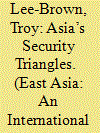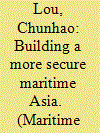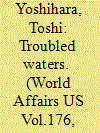|
|
|
Sort Order |
|
|
|
Items / Page
|
|
|
|
|
|
|
| Srl | Item |
| 1 |
ID:
160611


|
|
|
|
|
| Summary/Abstract |
Since the early years of the twenty-first century, a number of key regional governments have consciously chosen to alter the way they talk about the region, and have now largely shifted from using the ‘Asia-Pacific’ to the ‘Indo-Pacific’ construct. But after three decades of utilising the ‘Asia-Pacific’ concept, why has this been the case and how might this shift in geographical conceptualisation alter the strategic framework of the region? This paper argues that the ‘Indo-Pacific’ is a regional reconceptualisation utilised by Japan, Australia, India and the USA to address deficiencies in Asia’s maritime security and institutional architecture, which are being simultaneously influenced by a more assertive Chinese posture and waning U.S. influence. Additionally, the Indo-Pacific concept has developed in tandem with a transformation in the regional security architecture. The utilisation of maritime minilateralism between Japan, India, Australia and the USA supplements Asia’s bilateral American alliances, with an array of trilateral security dialogues or ‘security triangles’. The Asia-Pacific to Indo-Pacific shift is really an instance of an emerging minilateral security regionalism, rather than the predominant forms of bilateral and multilateral security and economic regionalism that have dominated Asia in recent decades.
|
|
|
|
|
|
|
|
|
|
|
|
|
|
|
|
| 2 |
ID:
144482


|
|
|
|
|
| Summary/Abstract |
In the past several years, maritime Asia has witnessed increasing security challenges, and this trend may persist in the near future. There are several underlying dynamics, including a geopolitical power game, lack of maritime governance and competition for maritime resources. However, in this globalised world, countries become quite interdependent and competition/confrontation is not the favourable policy choice. All countries share common interests in maintaining a stable maritime order, safeguarding the sea lines of communication (SLOCs) and developing a maritime economy. With China a rising maritime power, Chinese maritime policy has become important for Asia. Though incurring some misperception and misunderstanding, China will stick to its peaceful development strategy and try to foster a “harmonious ocean”, instead of resorting to the so-called “Neo-Mahanian Doctrine”. In achieving this, China will adopt an increasingly cooperative maritime policy, with the 21st-century Maritime Silk Road (MSR) initiative supplementing the effort.
|
|
|
|
|
|
|
|
|
|
|
|
|
|
|
|
| 3 |
ID:
193622


|
|
|
|
|
| Summary/Abstract |
Following victory in the Russo-Japanese War, the Meiji government sought to expand its maritime influence in Northeast Asia by developing pelagic fisheries in the newly acquired Kwantung leased territory, but it encountered immediate resistance from the Qing court, which had just embarked upon ambitious reform to strengthen maritime defence through the building of a national fishing industry. The dispute first emerged as a clash between Japanese and Chinese fishery protection companies on the seas adjacent to the Chinese city of Xiongyue. It then gave rise to a protracted Sino-Japanese legal debate on the question of whether the Xiongyue fishing ground was in the free sea or part of Chinese territorial waters. However, the 1912 settlement agreement made no mention of the legal status of the fishing ground. By examining this oft-neglected dispute, this article not only provides a rare East Asian case that illustrates the tension between the requirements of national sea borders and the principle of navigational freedom, but also explores how the Meiji and Qing governments perceived and practised international maritime law at the turn of the twentieth century. It argues that neither government viewed international maritime law as the only referential framework to solve the dispute, especially when it contributed little to the conflict settlement and contradicted their perceptions of the historical relations between East Asian countries.
|
|
|
|
|
|
|
|
|
|
|
|
|
|
|
|
| 4 |
ID:
128331


|
|
|
|
|
| Publication |
2014.
|
| Summary/Abstract |
Japan and China have been staring each other down in the East China Sea for well over a year now. Since Tokyo nationalized the Senkaku/Diaoyu Islands in September 2012, Chinese "maritime law enforcement flotillas" have been making the rounds in the disputed waters near the islands. China insists that the regular patrols are routine and normal. Japanese Coast Guard vessels have been working overtime to monitor and trail every Chinese intrusion, lest Tokyo concede Beijing's jurisdictional claims. Before this so-far low-decibel crisis began, it seemed unlikely that China would be willing to contest Tokyo's sovereignty over the uninhabited islands-islets is actually a better term to describe them-and administrative control over surrounding waters for as long as it has. And even fewer thought that Japan would be straining for an appropriate response. It is a testament to changing assumptions about China's growing ambitions that this protracted test of wills has gone largely unreported in the Western press. This cat-and-mouse game has seemingly become the new normal in maritime Asia.
|
|
|
|
|
|
|
|
|
|
|
|
|
|
|
|
|
|
|
|
|